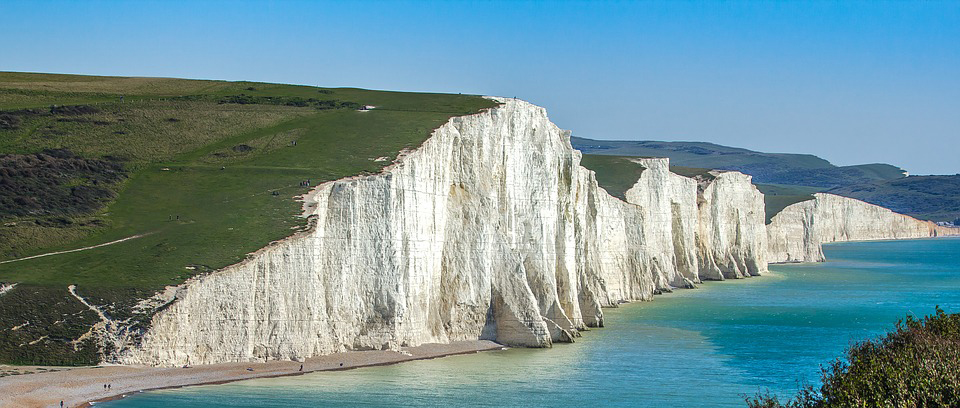Chalk

|
Contents |
[edit] Description
Chalk is a white, fine-grained, often soft crumbly type of limestone, made up of the shells of minute organisms that form into a sedimentary rock. Most chalk rocks were deposited during the Cretaceous period (145.5 million to 65.5 million years ago). It derives its name from the Latin word (creta) for chalk - although most Cretaceous rocks are not chalks.
The purest chalk rocks can be almost totally made up of calcium carbonate in the form of the mineral calcite, others will contain other materials such as quartz and silica as well as clay minerals and calcium phosphate. There are many chalk deposits along the Southern coast of England, which are dramatically exposed as white cliffs such as the white cliffs of Dover and the Seven Sisters in Sussex.
Chalk is porous and therefore can hold water, which can be advantageous for areas that suffer from drought because these rock types can provide a natural reservoir that releases water slowly.
In most cases chalk rocks can be easily accessed and examined as they are close to the surface and have not deformed over time.
[edit] Mining
Ancient chalk mines exist across much of southern England, associated with agriculture, often found next to field boundaries or woodland. Today, with seven of the ten leading global exporters, Europe has many mines, with France and Germany as top exporters. Chalk is generally open cast mined with a few closed cast mines.
[edit] Major uses
Today chalk is classified into natural and human-made chalk. Natural chalk as mined across Europe has been used as a raw material for quicklime, slaked lime and cement, it is also used in agriculture as a means of reducing the acidity of soils. Chalk has applications in power plants to neutralise acid gasses that are generated and as a filler and pigment in paper, plastic and construction materials. The traditional, more direct uses of chalk in construction also continue with in cob construction quicklime, bricks and builder's putty (with flaxseed oil) although this now often replaced with human-made chalk.
In 1965 the Institution of Civil Engineers organised a conference on the use of chalk in earthworks and foundations. In the UK, Chalk is used for a variety of civil engineering purposes including the construction of embankments for railways, trunk roads, motorways, fills, tunnels, cuttings, retaining structures, shallow foundations and pile foundations.
[edit] Minor uses
Other broader uses of natural chalk, now mostly replaced by human-made chalk, include the production of blackboard chalk (traditionally natural chalks now from mineral gypsum or calcium sulfate), and pavement, field and boundary marking chalk powder (now mostly titanium dioxide). In gymnastics, rock climbing, weight lifting and combat traction, magnesium carbonate is now generally used. Chalk used by tailors as well as carpenters was traditionally hard and now often made of magnesium silicate. Finally it is used as a mild abrasive and might be added to toothpaste, to help cleaning and as an additive to metal polish.
[edit] Related articles on Designing Buildings
Featured articles and news
The UK's Modern Industrial Strategy: A 10 year plan
Previous consultation criticism, current key elements and general support with some persisting reservations.
Building Safety Regulator reforms
New roles, new staff and a new fast track service pave the way for a single construction regulator.
Architectural Technologist CPDs and Communications
CIAT CPD… and how you can do it!
Cooling centres and cool spaces
Managing extreme heat in cities by directing the public to places for heat stress relief and water sources.
Winter gardens: A brief history and warm variations
Extending the season with glass in different forms and terms.
Restoring Great Yarmouth's Winter Gardens
Transforming one of the least sustainable constructions imaginable.
Construction Skills Mission Board launch sector drive
Newly formed government and industry collaboration set strategy for recruiting an additional 100,000 construction workers a year.
New Architects Code comes into effect in September 2025
ARB Architects Code of Conduct and Practice available with ongoing consultation regarding guidance.
Welsh Skills Body (Medr) launches ambitious plan
The new skills body brings together funding and regulation of tertiary education and research for the devolved nation.
Paul Gandy FCIOB announced as next CIOB President
Former Tilbury Douglas CEO takes helm.
UK Infrastructure: A 10 Year Strategy. In brief with reactions
With the National Infrastructure and Service Transformation Authority (NISTA).
Ebenezer Howard: inventor of the garden city. Book review.
The Grenfell Tower fire, eight years on
A time to pause and reflect as Dubai tower block fire reported just before anniversary.
Airtightness Topic Guide BSRIA TG 27/2025
Explaining the basics of airtightness, what it is, why it's important, when it's required and how it's carried out.
Construction contract awards hit lowest point of 2025
Plummeting for second consecutive month, intensifying concerns for housing and infrastructure goals.
Understanding Mental Health in the Built Environment 2025
Examining the state of mental health in construction, shedding light on levels of stress, anxiety and depression.





















